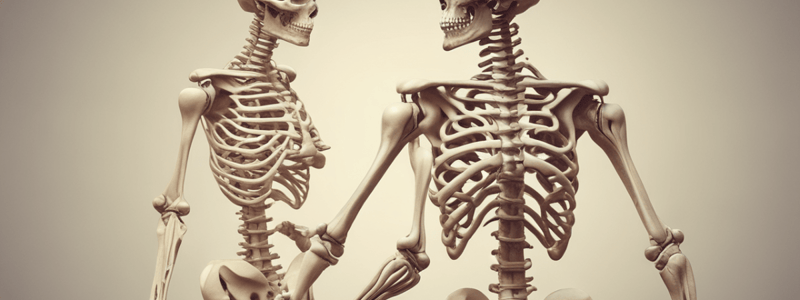Podcast
Questions and Answers
Match the type of arthritis with its characteristic manifestation:
Match the type of arthritis with its characteristic manifestation:
Osteoarthritis = Malaise and fever Rheumatoid Arthritis = Joint deformity (nodes)
Match the musculoskeletal disorder with its primary risk factor:
Match the musculoskeletal disorder with its primary risk factor:
Osteoporosis = Vitamin D deficiency Osteomalacia = Hormonal imbalance Rheumatoid Arthritis = Malnutrition Osteoarthritis = Vitamin D deficiency
Match the complication of MS disorders with its characteristic manifestation:
Match the complication of MS disorders with its characteristic manifestation:
Compartment Syndrome = Malaise and fever Malignant Hyperthermia = Pain, pallor, poikilothermia, pulselessness, paresthesia, paralysis Rhabdomyolysis = Joint deformity (nodes)
Match the term with its definition:
Match the term with its definition:
Match the type of arthritis with its characteristic joint affectation:
Match the type of arthritis with its characteristic joint affectation:
Match the condition with its characteristic bone structure:
Match the condition with its characteristic bone structure:
Match the term with its characteristic clinical manifestation:
Match the term with its characteristic clinical manifestation:
Match the musculoskeletal disorder with its characteristic risk factor:
Match the musculoskeletal disorder with its characteristic risk factor:
Match the term with its definition related to musculoskeletal disorders:
Match the term with its definition related to musculoskeletal disorders:
Match the condition with its characteristic preventative measure:
Match the condition with its characteristic preventative measure:
Match the following musculoskeletal disorders with their primary characteristics:
Match the following musculoskeletal disorders with their primary characteristics:
Match the following types of fractures with their descriptions:
Match the following types of fractures with their descriptions:
Match the following musculoskeletal traumas with their definitions:
Match the following musculoskeletal traumas with their definitions:
Match the following conditions with their effects on bone:
Match the following conditions with their effects on bone:
Match the following musculoskeletal disorders with their primary locations:
Match the following musculoskeletal disorders with their primary locations:
Match the following terms with their definitions related to fractures:
Match the following terms with their definitions related to fractures:
Match the following symptoms with their corresponding musculoskeletal disorders:
Match the following symptoms with their corresponding musculoskeletal disorders:
Match the following conditions with their suspected causes:
Match the following conditions with their suspected causes:
Match the following musculoskeletal disorders with their effects on joint movement:
Match the following musculoskeletal disorders with their effects on joint movement:
Match the following terms with their descriptions related to musculoskeletal traumas:
Match the following terms with their descriptions related to musculoskeletal traumas:
Match the following terms with their definitions:
Match the following terms with their definitions:
Match the following conditions with their characteristic symptoms:
Match the following conditions with their characteristic symptoms:
Match the following terms with their correlations:
Match the following terms with their correlations:
Match the following terms with their descriptions:
Match the following terms with their descriptions:
Match the following terms with their characteristics:
Match the following terms with their characteristics:
Match the following terms with their associations:
Match the following terms with their associations:
Match the following terms with their treatments:
Match the following terms with their treatments:
Match the following terms with their consequences:
Match the following terms with their consequences:
Match the following terms with their definitions:
Match the following terms with their definitions:
Match the following terms with their characteristics:
Match the following terms with their characteristics:




